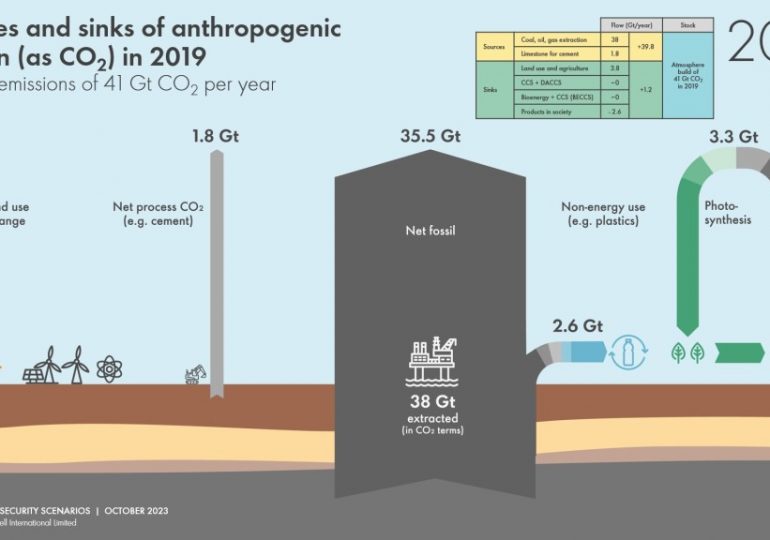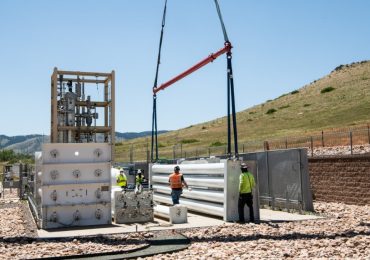In the run-up to COP28 and at the conference itself, a key call by some nations and many observers is to include language in the COP decisions to signal the phase out of fossil fuels. While there is no question that the carbon dioxide emissions from the use of fossil fuels and any leakage of natural gas (primarily methane) to the atmosphere is the main cause of the rising global average surface temperature, is it premature for such a call and should phase-out be the all-consuming drive at this stage of the transition? It is of course the obvious answer to the problem of limiting carbon dioxide emissions to a finite amount, but obvious answers aren’t always the right ones.
Given time, there is little doubt that society will move on from thermal combustion as a source of energy, even though it has been the only large-scale source of energy for millennia. Once that happens there will be little need for fossil fuels. We are in an era of rapid technological change and exciting developments in multiple fields of science, with energy production now tending to move into the quantum realm, as information technology has been doing over the past 70 years. Come back in a century or so and the energy world will likely be very different. But that doesn’t help the immediate problem of emissions mitigation.
To better understand the challenge today, Shell uses scenarios to look at nearer term trends and The Energy Security Scenarios released earlier in 2023 are the perfect tool to shed light on the question of fossil fuel phase out. But first, it is important to look at the reality of where we are today. We still live in a society that is utterly dependent on fossil fuels for the delivery of most energy services, such as lighting, heat, mobility, information transfer and powering rotational equipment (pumps, compressors etc.). The production of most goods either includes fossil carbon directly (e.g. plastics, bitumen, cosmetics, medicines etc.) or requires fossil fuels in the production chain. The transition is under way, but the percentage of fossil fuels in the global energy mix has remained at around 80%, even after a quarter century of sustained effort to shift that dependency. However, the pace of change is accelerating. The current global emissions picture for a world powered mainly by fossil fuels is illustrated below.
Phasing out fossil fuels means finding a substitute for the delivery of every single energy service or manufactured item that exists today. Therein lies the problem – the substitutes don’t exist yet, at least not at a scale that matches the delivery potential of fossil fuels. This starts with very humble items, such as the pencil, which I discussed in a recent blog post but extends through to the entire electricity grid. Solar and wind are here to stay, but the complete set of technologies required to power cities with them all the time, overcoming the inherent intermittency of these energy sources, are still in the early stages of development. Similarly, the technologies to make green hydrogen, green ammonia, sustainable aviation fuels, synthetic hydrocarbons using atmospheric carbon dioxide and green hydrogen all exist but operate on a small or in some cases even pilot scale, whereas global oil production alone fills two 330-metre-long super-tankers every hour.
At a recent refinery technology conference I attended, there was real interest in processes to make sustainable aviation fuels, from relatively straightforward hydrotreating of waste oil to complete synthesis of jet fuel from carbon dioxide and hydrogen. Refiners want to do this, and aviation companies are starting to look for these fuels, but the industry is at the beginning of a long-haul development process to completely replace fossil-based aviation fuel. And if our thoughts then turn to electric or even hydrogen powered planes, these are still on the drawing board. Development and widespread deployment of new energy technologies on a global scale is measured in decades, not in years.
When the Shell scenario team developed The Energy Security Scenarios we thought hard about these timelines for change and considerable research went into understanding when technologies might emerge at scale. Two transition scenarios are presented, Sky 2050 which is largely devoid of headwinds and builds on global mutual interest, and Archipelagos which sees national self interest prevail and act as a drag on the energy transition when compared to Sky 2050. In Sky 2050 which achieves net-zero emissions globally by 2050, fossil fuel use is still commonplace in that year, albeit reduced by nearly two-thirds when compared to today. Substitutes are being found and alternative services delivered, but not fast enough to phase out fossil fuels on a timeline that matches the need for net-zero emissions.
The short answer is that net-zero emissions should take precedence over fossil fuel phase out because it can be achieved more readily and in a shorter time frame. But even net-zero emissions in the shorter term, such as by 2050, will require not just considerable fossil fuel substitution effort but also considerable use of every available carbon removal mechanism. In the Sky 2050 illustration below, remaining emissions (fossil energy and cement) of 8.4 Gt per year in 2050, even after the direct use of carbon capture and storage (CCS), is balanced by carbon removals delivered mainly through land use change, some direct air capture with geological storage (DACCS) and bioenergy production linked with geological storage (BECCS). But as noted, there has been considerable substitution away from fossil fuels as an energy source when compared to now.
A strategy that builds on the notion that all fossil fuel use can be ended by 2050 is likely to fail, whereas one that focuses on net-zero and embraces the seeming ambiguity and apparent messiness of such a solution can succeed. But it is just an interim step towards a world where fossil fuel use has largely ended. By late in the century in Sky 2050, fossil fuel use is a tiny fraction of today and most of that remaining use is as a ready source of carbon for making things, like plastic products. The fossil fuel use for combustion processes is in limited legacy applications where facilities that were built years earlier with CCS are still operating. But direct use of CCS has declined considerably compared to 2050 as industrial concerns use hydrogen, bioenergy and electricity to power their facilities.
Fossil fuel phase-out is a handy catch phrase that attracts interest and seemingly presents a solution to rising global temperatures, but it may not be the best immediate solution. A focus on net-zero and the development of policy instruments to encourage a balance between remaining emissions and various sink technologies and land use practices is where we need to be, but such a framework is proving hard to realize. Nevertheless, the USA is doing it now with a pioneering incentive scheme aimed at both new energy technologies and carbon emissions management; perhaps a trillion US dollars will flow into this full range of transition technologies. And in Australia a carbon farming initiative (CFI) has been running for some years which incentivizes farmers to maximize land carbon stock as an important output from their agricultural activities, such as growing wheat and raising cattle.
As COP28 gets underway, the fossil fuel phase out discussion may get very heated, and while it is an important discussion to be had, it should not become a distraction to the shorter-term goal of net-zero emissions, which will require a major emphasis on the development of carbon removal practices and technologies.
Note: Shell Scenarios are not predictions or expectations of what will happen, or what will probably happen. They are not expressions of Shell’s strategy, and they are not Shell’s business plan; they are one of the many inputs used by Shell to stretch thinking whilst making decisions. Read more in the Definitions and Cautionary note. Scenarios are informed by data, constructed using models and contain insights from leading experts in the relevant fields. Ultimately, for all readers, scenarios are intended as an aid to making better decisions. They stretch minds, broaden horizons and explore assumptions.
Leave a comment









